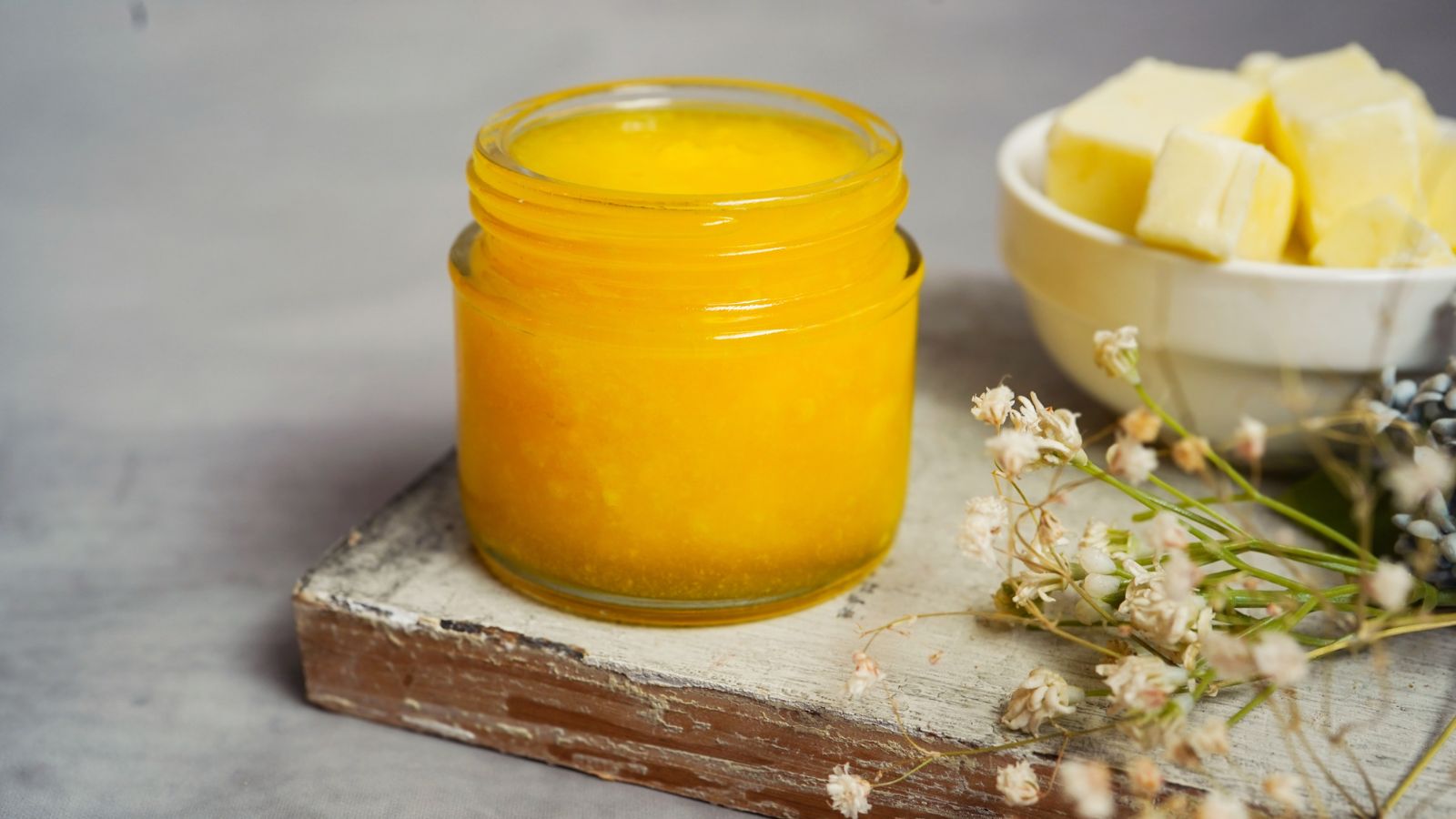
Ghee vs Clarified Butter: A Simple Guide for Home Cooks and Food Lovers
Photo Credit: Canva Pro
There is a difference between ghee and clarified butter, even though they look the same. Both are made from butter, but they are cooked and used in different ways. Ghee takes longer to cook and tastes rich and nutty. Clarified butter has a clean taste and is ideal for high-temperature cooking due to its high smoke point.
This article talks about the main differences between them, how to use them best, and which is better for your kitchen and diet. Let's get rid of all the doubts for good.
✨ 👉 Click Here to Try Traditional Ghee Now! Nourish your meals with this clean, clarified butter!
Ghee vs Clarified Butter – What’s the Real Difference?
Photo Credit: Canva Pro
What Is Clarified Butter?
When you heat butter, the water and milk solids are taken out, leaving behind clarified butter. Nothing but pure butterfat is left. It's great for cooking at high temperatures because it has a high smoke point and lasts longer.
-
Base ingredient: Unsalted butter, known for its clean, pure fat content
-
How it’s made: Slowly melted over medium low heat to separate the water and milk solids
-
Key benefit: High smoke point makes it great for sautéing, frying, and even roasting
-
Flavor profile: Mild, clean taste—perfect when you don’t want to overpower a dish
-
Storage: Lasts for months without refrigeration when stored in an airtight jar
What Is Ghee and How Is It Different?
It's a type of clarified butter that's cooked longer until the milk solids turn brown. This makes brown butter that smells rich and nutty and has sweeter taste.
-
Extended cooking: Ghee is made by turning butter past the clarified stage until the solids brown and sink
-
Color and taste: Deep gold color and toasted, aromatic flavor
-
Shelf life: Longer than normal butter—ideal for hot climates and pantry storage
-
Flavor boost: Adds depth to baked goods and complex dishes
-
Best for: Cooking fats in Indian recipes or when the recipe calls for bold, buttery flavor
Is Ghee Just Melted Butter?
Photo Credit: Canva Pro
The Step-by-Step Ghee-Making Process
Melted butter is not the same thing as ghee. It starts the same, but it goes farther. You only need unsalted butter and some time to make your own ghee at home.
-
Step 1: Melt unsalted butter on low heat to begin separating water and milk solids
-
Step 2: Skim the foam as water evaporates from the top
-
Step 3: Keep heating butter until the milk solids brown at the bottom
-
Step 4: Strain through a coffee filter or fine mesh to remove solids completely
-
Step 5: Let it cool and store in a clean jar—no refrigeration needed
Traditional and Holistic Uses of Ghee
Ghee isn't just fat for cooking. For hundreds of years, it has been used in Ayurveda and cultural ceremonies because it is thought to heal and be pure.
-
In Ayurveda: Used in massage oils, detox treatments, and herbal medicine
-
For digestion: Contains butyrate, which supports gut health
-
In religion: Burned in sacred lamps and ceremonies
-
Flavor enhancer: Boosts richness in rice, curries, and even baked goods
-
Practical perk: Doesn’t spoil easily, making it a smart pantry staple
Which Is Better – Ghee or Clarified Butter?
Photo Credit: Canva Pro
Comparing Nutritional Profiles
Both ghee and clarified butter have similar fat content and are free of lactose when the milk solids are removed, but ghee may offer slight health advantages.
-
Fat content: It is similar to butter; some claim it's easier to digest due to absence of milk solids, though scientific consensus is limited.
-
Butyrate in ghee: Ghee contains butyrate, a short-chain fatty acid associated in some studies with gut health, though more human research is needed.
-
Lactose-friendly: Ghee may be better tolerated by those with mild dairy sensitivities, though trace amounts of lactose or casein can remain
-
Cholesterol concerns: Use moderately, as both are still high in saturated fat
When to Use Each for Best Results
Each can be used in different ways, and the one you choose will depend on the taste you want and how you plan to cook it.
-
Use ghee for: Indian dishes, baking recipes, or when a rich, nutty flavor is desired
-
Use clarified butter for: Frying, sautéing, and recipes that call for neutral cooking fats
-
Flavor notes: Ghee offers a deeper taste, clarified butter is more neutral
-
Versatility: Clarified butter can be mixed with olive oil or vegetable oils for different textures
-
Heat handling: Both are excellent for high temperature cooking due to their smoke point
Can You Fry with Clarified Butter?
Photo Credit: Canva Pro
Smoke Point and Why It Matters
Using clarified butter and ghee for frying is great because the milk solids are taken out, which raises the smoke point. Although regular butter burns easily because it contains water, these fats don't change when heated up.
-
No water content: Clarified butter won’t spit or burn like ordinary butter
-
High smoke point: With milk solids removed, it’s safe for high-heat frying and searing
-
Consistency: The liquid fat coats food evenly for a golden crust
-
Shelf stability: Can be kept outside the fridge for weeks if sealed properly
-
Best for: Frying eggs, pancakes, searing meat, and finishing vegetables
Best Frying and Searing Applications
Clear butter can be used instead of oil in many dishes, from breakfast eggs to golden fish fillets. It tastes like butter and can handle heat better than olive oil.
-
Pan frying: Ideal for cutlets, shrimp, and breaded chicken
-
Popcorn: A drizzle of clarified butter turns plain popcorn into a delicious snack
-
Vegetables: Roast root veggies or greens with clarified butter for depth
-
Quick sauces: Deglaze the pan after searing to create flavorful drizzles
-
Versatile: Also great on bread, or brushed onto baked goods
What FullyHealthy Offers for Ghee Lovers
Pure Traditions Grass-Fed Ghee – A Spotlight
Pure Traditions ghee, which is made in small batches with cultured butter, is sold at FullyHealthy. It means that the traditional way of making ghee is to slowly simmer it in a saucepan until the milk solids turn into caramel.
-
Quality butter: Made from cultured, grass-fed butter with milk solids removed
-
Cooking process: Gently heated until the ghee turns into a rich, golden liquid
-
Flavor: Slightly nutty, close to beurre noisette in aroma
-
Texture: Smooth and spreadable, perfect for bread or finishing dishes
-
Storage: Shelf-stable, no fridge needed
Why Shop at FullyHealthy?
This website is more than just a grocery store; it's a specialty store for people who are trying to avoid allergens, follow the AIP, or find unique products. They only stock things that meet strict standards for ingredients.
-
Curated items: Every product meets strict diet criteria
-
No need to boil labels: Clean ingredient transparency
-
Customer-friendly: No membership or confusing subscriptions
-
Great for baking: Use their ghee in baked goods or melted on popcorn
-
Exclusive items: Pure Traditions ghee is not found everywhere
Final Thoughts
Ghee and clarified butter are not the same, but they are both useful in the kitchen in different ways. Clarified butter is better for cooking or making sauces because it is cleaner and lighter.
When you want something rich, use ghee. When you want something light, use clarified butter. Pure ghee and clarified butter are both good for baking, frying meat, and spreading on bread.
FAQs
Can I use clarified butter instead of olive oil?
Yes, clarified butter works well as a substitute for olive oil in high-heat cooking. It has milk solids removed and handles heat better.
How is ghee different from ordinary butter?
Ghee is made by simmering ordinary butter a bit longer until milk solids are removed and a rich flavour develops.
Do I need to store clarified butter in the fridge?
No, clarified butter has no water content and can be stored outside the fridge. Just keep the liquid in a sealed container.
Can I use ghee in pastry or baked goods?
Yes, ghee adds a deep flavour and crispness to pastry. It’s perfect for both baking recipes and greasing the pan.
What’s the difference between clarified butter and beurre noisette?
Clarified butter is pure butterfat. Beurre noisette is butter browned with solids intact, while ghee is clarified and strained to remove all solids.

Leave a comment